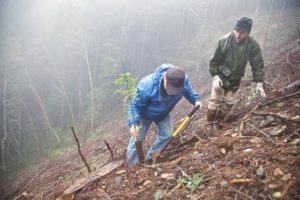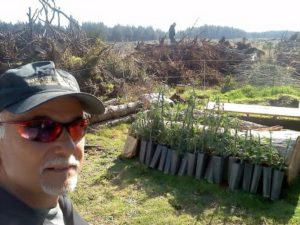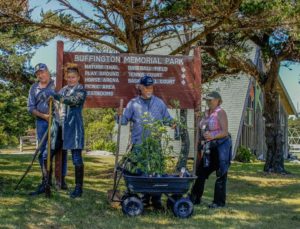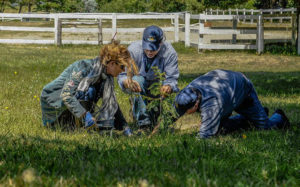During our expedition to California to harvest clone material from ancient giant sequoias and coast redwoods, I wanted to know what these cloned cuttings would look like as young saplings, even though it would take decades to see what they would look like as mature trees.
Fortunately, the 2016 Archangel expedition was not the first of its kind. Cuttings from ancient giant sequoias and coast redwoods have been obtained numerous times already by Archangel starting several years ago. Many of those are now fully rooted saplings, with the same DNA as the mother trees, and have been planted in various sites around the world.

The first area that was determined to be the most conducive to planting Archangel champion giant sequoia and coast redwood clones was the area located near Port Orford, Oregon. Just north of the coast redwood’s current “native” range, the Port Orford Community Stewardship Area was selected because of ongoing climate change and as a hedge in case global warming weakens the trees down south.
On December 4, 2012, the World’s First Planting of a Champion Redwood & Sequoia Forest began during a raging winter storm when the first two ancient trees cloned from some of the largest and oldest redwoods and giant sequoias in California were planted on a steep hillside in remote southern Oregon in the heart of the Port Orford Community Stewardship Area. When the weather became more favorable, another 248 Archangel clones were added to the same four acre site on Ocean Mountain Ranch.

Dec 4, 2012 Planting the first Archangel champion coast redwood clone at Ocean Mountain Ranch south of Port Orford, Oregon.
This planting was Archangel’s first attempt to go beyond cloning and archiving in order to re-create an old-growth forest from its storehouse of rooted cuttings from “champion” trees – the oldest and largest specimens of each species that could be found.

On that historic, foggy, windy and rainy day in December 2012, this was the second of the first two coast redwoods planted at Ocean Mountain Ranch on a remote hillside south of Port Orford, Oregon.
Over the intervening years between 2012 and 2016, one thousand more plantings of Archangel clones occurred in various parts of the Port Orford Community Stewardship Area near Port Orford, Oregon. Below are photos from just a few of those plantings.

2013 Earth Day planting at Pacific High School

Archangel champion coast redwood clones arrive at Cedar Grove Farm in Port Orford Community Stewardship Area near Port Orford, Oregon.

Archangel champion coast redwood clones arrive in Port Orford Community Stewardship Area to restore a clear cut property near Port Orford, Oregon.

June 2015 – Preparing to plant Archangel champion coast redwood clones in a local park in Port Orford, Oregon.

June 2015 – Planting Archangel champion coast redwood clones in local park in Port Orford, Oregon.

Presenting a tree planting program at Curry County library.

Port Orford Rotary Club members plant Archangel champion coast redwood clone in town.

Planting Archangel champion coast redwood clones at Curry County Park.
Meanwhile, on a different continent . . .
March 14, 2016 – Forty Archangel champion coast redwood trees were planted at the Eden Project in the south-west of England, the first time a “forest” of these big friendly giants from North America has been introduced to Europe.

Children at The Eden Project form a 109 foot circle – the circumference of the Fieldbrook Stump, the source from which many of Archangel’s coast redwood saplings were cloned.
Archangel Provides Trees for Europe’s First Champion Redwood Forest

Children ready to plant 40 champion coast redwood clones at the Eden Project in Cornwall, UK.


Philip,
Thanks for the time and effort to put together this great expedition blog.
Terry Mock, Trustee
Ocean Mountain Ranch
Made for excellent reading – great work 🙂
Philip:
Wonderful expedition blog and very informative! Enjoyed learning more about trees, their planting, etc.
As a native of western Cornwall I’m hoping those beautiful trees manage to withstand those Atlantic gales. I,m sure they’ve found a sheltered spot in which to tenderly plant.
Hello. Recently, new coast redwoods wider than giant sequoia have been discovered, even exceeding the 1321 champion points of General Sherman by no less than 40 points. This autumn brought a new revelation … a hidden spring, showing once again that conditions are the factor for the largest redwoods, much more so than any hypothetical super DNA. Let alone that the world’s tallest redwood’s tissue was surpassed by that of “regular” redwoods in an experiment not long ago. Updates are available at this page which I wlll also provide in the site box option which I think links my user name >> http://www.mdvaden.com/redwood_year_discovery.shtml
I live in the UK on the border between Shropshire and Wales and come across adolescent Coast Redwoods frequently, but
the mountainous Sequoias are more rare, I believe their habitat is in protected cloistering, where the wind, the hot sun and infection doesn’t penetrate the woodland cloister.
I’ll make a point of taking my grandsons to see them often enough to take a lifelong interest in them. Fantastic!
I just measured the 10 Issaquah trees (9/3/2019). Two of them are over 9 feet. Is there a focal point for collecting periodic measurements?
September or October are good months to collect periodic measurements as the trees are pretty much done with their summer season growth spurt before going dormant throughout the winter months.